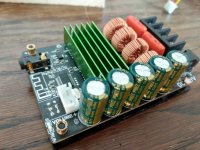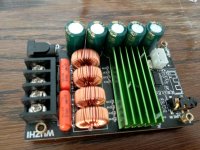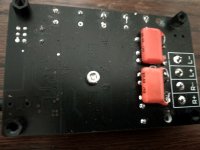I bought this module off Aliexpress.
The bluetooth is, as I expected, unusable because it degrades the sound quality a whole lot. I can live with that since I don't plan on using it anyway.
The volume pot however has a problem that I do wish to get rid off.
The pot is one with an integrated power switch. I think they did that to tackle the startup plop problem.
However I've noticed that turning the knob creates a DC offset. I see the speaker cone move outward or inward as I turn the knob left or right. The faster I turn, the more this problem occurs. As if turning the pot somehow generates a voltage on the signal line.
I do not wish to damage my speaker drivers, so I want to find the root of this problem. Is it a faulty pot, or is it a faulty amplifier design?
If anyone has an idea what could cause this phenomenon, please let me know.
Quoting myself because I've found the solution, and implemented some changes that make this amp sound very good. Even the bluetooth doesn't degrade the sound quality as far as I can hear!
The problem with the volume knob is that it is too close to the bluetooth antenna. Also it is a shitty pot, so I removed it and shorted the pot input/output pins on the board. Because the pot also doubles as on/off switch, so I made a connector socket it's place and wired a connector to a switch.
I swapped out the 470uF power supply filter capacitors for 35v 2200uF ones. That made an enormous improvement in sound quality!
I also changed the output filter caps for locally sourced MKT ones. They are way too big to fit so I had to put 2 on the bottom side. Next time I'll take 68v rated caps with a lead spacing of 5mm.
I've have yet to find a decent way of wiring a volume pot external from the board. I think it'll need a NE5532 buffer or at least some bigger input capacitors for that. Right now it is of no concern for me.
There is no on/off plop. There is a little hiss when I connect my phone through the aux port. I have tried the 4k7 resistors to ground but that made no difference.
Using bluetooth the amp has no hiss at all.
It's not the best module around the 10eu point but I haven't had one with bluetooth that sounded good for that price
Attachments
Im impressed how good the amp sounds with my 89db sensitive rated speakers, 8 ohm with a minimum just under 4ohm.
Im still on the 19 voilt 4.7a power supply with -10 db attenuators and have enough power 95% of the time
With no attenuators the music is super loud a 12 o'clock even when theres no sound at 9 o'clcok
Im still on the 19 voilt 4.7a power supply with -10 db attenuators and have enough power 95% of the time
With no attenuators the music is super loud a 12 o'clock even when theres no sound at 9 o'clcok
The best 3116 is described in this post: TPA3116D2 Amp
My implementation of it and a proper comparison with a 3886 can be read from the link below
Cheers
My implementation of it and a proper comparison with a 3886 can be read from the link below
Cheers
Im still on the 19 volt 4.7a power supply with -10 db attenuators and have enough power 95% of the time (i just have to turn it all the way up, no distortion).
Which surprised me and it sounds good
Which surprised me and it sounds good
The best 3116 is described in this post: TPA3116D2 Amp
My implementation of it and a proper comparison with a 3886 can be read from the link below
Cheers
Thanks for this. Can it be bridged to mono?
Hello Eshamp,
If you look at the 3116 data sheet you will see that one chip is a stereo amp. On this board there are two chips both working in bridged mono.
Cheers
If you look at the 3116 data sheet you will see that one chip is a stereo amp. On this board there are two chips both working in bridged mono.
Cheers
Yep missed that, thanks. On the plethora of 2 channel TPA3116D2 bluetooth amps, I am trying to figure out where the input capacitors are so I can switch to mono as per datasheet. Like on this one for example. Any one have any idea?


In the board you linked these would be the input caps:

But how are you going to use the bluetooth feature on mono?

But how are you going to use the bluetooth feature on mono?
Thanks. I imagine I would need to remember to set my phone to output mono to Bluetooth. It's an option on iPhones, but I don't know about android.
Or can I do the summing to mono after the input caps?
Or can I do the summing to mono after the input caps?
You'd loose the stereo imaging. I presume you'd have to have two boards, and somehow be connected via bluetooth to both, and use left channel on one board and right channel on the other.
But then you have delay issues, I'm not sure the bluetooth devices would be in sync.
You could disable one bluetooth chip and route one channel via wire between boards.
But then you have delay issues, I'm not sure the bluetooth devices would be in sync.
You could disable one bluetooth chip and route one channel via wire between boards.
No sure I follow. I'd be summing to mono and using on a single speaker, so stereo imaging isn't an issue?
I am new to this thread, my reading is on Page 90 at the moment.....still a long way to go 😛😛
But I do have a question to ask 🙄 please.....
Has anyone compared the musical quality of the TPA 3116 in PBTL and in BTL mode in stereo application (not in sub woofer application) ??
In stereo application, which should be the prefer mode ? 100W * 2 or 50W * 2 please ?
But I do have a question to ask 🙄 please.....
Has anyone compared the musical quality of the TPA 3116 in PBTL and in BTL mode in stereo application (not in sub woofer application) ??
In stereo application, which should be the prefer mode ? 100W * 2 or 50W * 2 please ?
Hello
I can't give you an answer to Q1
Q2 simply put if you were able to put even 50 watts into a loudspeaker it would disintegrate, here's an extract from my blog, link below.
"With the amp at waking the dead volume and a full range wall of electronic music. I connected an ammeter in series with the +V output it registered between 0.2 to 0.4 Amps.
At 12v x 0.4 Amps = 4.8 Watts divided by 2 = 2.4 Watts per speaker less 10% for efficiency wastage = 2.16 Watts or 1/2 that at 0.2 Amps"
Cheers
I can't give you an answer to Q1
Q2 simply put if you were able to put even 50 watts into a loudspeaker it would disintegrate, here's an extract from my blog, link below.
"With the amp at waking the dead volume and a full range wall of electronic music. I connected an ammeter in series with the +V output it registered between 0.2 to 0.4 Amps.
At 12v x 0.4 Amps = 4.8 Watts divided by 2 = 2.4 Watts per speaker less 10% for efficiency wastage = 2.16 Watts or 1/2 that at 0.2 Amps"
Cheers
Sure, but audio is not a constant load. When it is finally time for the bass to drop, you might just need a lot more watts.
That being said 50w still is a huge amount. And in my experience if that gives you not enough decibels, a little NE5532 preamp solves that.
That being said, the 2x 100w TPA3116D2 modules don't cost that much more that single chip 2x 50w ones. So I see no real reason not to get those while you are at it.
That being said 50w still is a huge amount. And in my experience if that gives you not enough decibels, a little NE5532 preamp solves that.
That being said, the 2x 100w TPA3116D2 modules don't cost that much more that single chip 2x 50w ones. So I see no real reason not to get those while you are at it.
I believe the general consensus is that this one is currently the best tpa3116d2 for under 10 units of your preferred currency. I have not yet tried it myself.
KYYSLB DC12 24V High Power 100W*2 TPA3116D2 Digital Power Amplifier Board XH M590 Home Audio Amplifier Board 2~8 Ohms|Amplifier| - AliExpress
KYYSLB DC12 24V High Power 100W*2 TPA3116D2 Digital Power Amplifier Board XH M590 Home Audio Amplifier Board 2~8 Ohms|Amplifier| - AliExpress
Remember that 100 watts is for 2 ohm loads. Can your 24 volt power supply supply 10 amps peak per channel? 20 amps total. Probably not. If you have 4 ohm speakers that dip below 3 ohms at different frequencies the 2 x 100 watt amp may be your ticket. Do you have a 2 ohm sub? Or dual 4 ohm sub.
- Home
- Amplifiers
- Class D
- TPA3116D2 Amp


